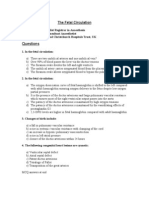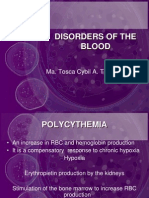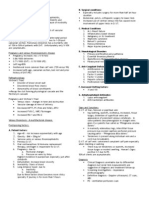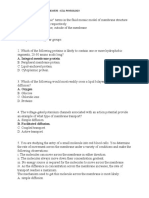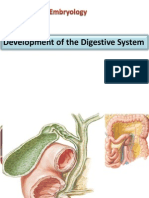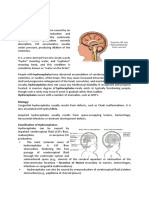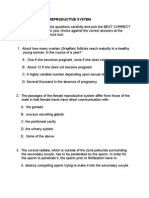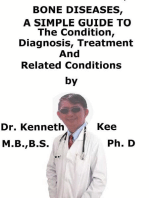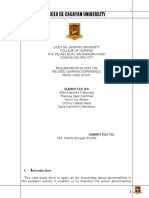0 ratings0% found this document useful (0 votes)
1K views2 Anatomy and Physiology of The Breast and Lactation
2 Anatomy and Physiology of The Breast and Lactation
Uploaded by
Paul Michael BaguhinThe document discusses the anatomy and physiology of the breast and lactation. It describes how the breast enlarges during pregnancy due to hormones like estrogen, progesterone, and prolactin. It explains that oxytocin stimulates milk secretion and is released during let down when the baby sucks, causing milk to travel from the alveoli through ducts. Prolactin levels rise with nipple stimulation during breastfeeding, causing alveolar cells to make milk.
Copyright:
© All Rights Reserved
Available Formats
Download as PPTX, PDF, TXT or read online from Scribd
2 Anatomy and Physiology of The Breast and Lactation
2 Anatomy and Physiology of The Breast and Lactation
Uploaded by
Paul Michael Baguhin0 ratings0% found this document useful (0 votes)
1K views15 pagesThe document discusses the anatomy and physiology of the breast and lactation. It describes how the breast enlarges during pregnancy due to hormones like estrogen, progesterone, and prolactin. It explains that oxytocin stimulates milk secretion and is released during let down when the baby sucks, causing milk to travel from the alveoli through ducts. Prolactin levels rise with nipple stimulation during breastfeeding, causing alveolar cells to make milk.
Original Description:
hgyfr
Original Title
2-Anatomy-and-Physiology-of-the-Breast-and-Lactation
Copyright
© © All Rights Reserved
Available Formats
PPTX, PDF, TXT or read online from Scribd
Share this document
Did you find this document useful?
Is this content inappropriate?
The document discusses the anatomy and physiology of the breast and lactation. It describes how the breast enlarges during pregnancy due to hormones like estrogen, progesterone, and prolactin. It explains that oxytocin stimulates milk secretion and is released during let down when the baby sucks, causing milk to travel from the alveoli through ducts. Prolactin levels rise with nipple stimulation during breastfeeding, causing alveolar cells to make milk.
Copyright:
© All Rights Reserved
Available Formats
Download as PPTX, PDF, TXT or read online from Scribd
Download as pptx, pdf, or txt
0 ratings0% found this document useful (0 votes)
1K views15 pages2 Anatomy and Physiology of The Breast and Lactation
2 Anatomy and Physiology of The Breast and Lactation
Uploaded by
Paul Michael BaguhinThe document discusses the anatomy and physiology of the breast and lactation. It describes how the breast enlarges during pregnancy due to hormones like estrogen, progesterone, and prolactin. It explains that oxytocin stimulates milk secretion and is released during let down when the baby sucks, causing milk to travel from the alveoli through ducts. Prolactin levels rise with nipple stimulation during breastfeeding, causing alveolar cells to make milk.
Copyright:
© All Rights Reserved
Available Formats
Download as PPTX, PDF, TXT or read online from Scribd
Download as pptx, pdf, or txt
You are on page 1of 15
Anatomy and Physiology of
the Breast and Lactation
OBEDENCIO
SERANIA
Lactation
Anatomy and Physiology
• Breast Enlargement
During pregnancy and lactation indicate the
mammary glands are becoming functional
Breast size before pregnancy does not
determine the amount of milk a women will
produce
Lactation
Anatomy and Physiology
• Hormones during pregnancy
Estrogen stimulates the ductile system to grow,
then estrogen levels drop after birth
Progesterone increases the size of alveoli and
lobes
Prolactin contributes to increasing the breast
tissue during pregnancy
Lactation
Anatomy and Physiology
Alveoli secrete milk and contract when
stimulated
Oxytocin stimulates milk secretion and is
released during the let down or milk ejection
reflex
After let down, milk travels into the ductules,
then to the larger- lactiferous or mammary ducts
Lactation
Anatomy and Physiology
•Hormones during breastfeeding
Prolactin levels rise with nipple stimulation
Alveolar cells make milk in response to
prolactin when the baby sucks
Oxytocin causes the alveoli to squeeze the
newly produced milk into the duct system
Lactation
Anatomy and Physiology
Physiology of Lactation
Mammagonesis
LACTOGENISIS
LACTOGENISIS
Pathways for milk secretion by the mammary
epithelial cells
LACTOGENISIS
Galactokinesis
Galactopoiesis
Involution
You might also like
- Engineering Mechanics - Statics-J.L.Meriam - L.G.Kraige-Solution Manual (5th Ed) PDFDocument984 pagesEngineering Mechanics - Statics-J.L.Meriam - L.G.Kraige-Solution Manual (5th Ed) PDFStone100% (2)
- Foetal CirculationDocument8 pagesFoetal CirculationMujahid_Dean_8976100% (1)
- Anatomy of Breast, Milk Production, and Milk-EjectionDocument23 pagesAnatomy of Breast, Milk Production, and Milk-EjectionDeepak Ghimire100% (3)
- Yu - Git - Emb 2Document56 pagesYu - Git - Emb 2gtaha80No ratings yet
- West Bengal University of Health Sciences: Name of The InstitutionDocument9 pagesWest Bengal University of Health Sciences: Name of The InstitutionVarun Mohanakumaran RajambikaNo ratings yet
- Normal Labour& Abnormal LabourDocument23 pagesNormal Labour& Abnormal LabourThetnaungsoe100% (1)
- Genital Ulcer DiseaseDocument29 pagesGenital Ulcer DiseaseFu' BudhyNo ratings yet
- Lymphatic Drainage of Abdomen: Learning ObjectivesDocument5 pagesLymphatic Drainage of Abdomen: Learning ObjectivesUloko ChristopherNo ratings yet
- Choose The Best AnswerDocument27 pagesChoose The Best AnswerHusseini ElghamryNo ratings yet
- 01embryology of Genitalia TawhariDocument10 pages01embryology of Genitalia TawhariMelissa Aina Mohd YusofNo ratings yet
- High Vaginal SwabbingDocument7 pagesHigh Vaginal SwabbingMiriward ZimbaNo ratings yet
- Disorders of The BloodDocument35 pagesDisorders of The BloodNoor IbrahimNo ratings yet
- Anatomy of Male Reproductive OrgansDocument18 pagesAnatomy of Male Reproductive OrgansPutri HolmesNo ratings yet
- MCQ AnatomyDocument2 pagesMCQ AnatomyAzza EsaNo ratings yet
- Inflammatory DisordersDocument18 pagesInflammatory Disordersfebie pacheco100% (1)
- Urogenital Embryology & AnatomyDocument93 pagesUrogenital Embryology & Anatomydr.hendraNo ratings yet
- Factors Influencing Umbilical Cord Care Practices Among Mothers Attending Infant Welfare Clinic in Selected PrimarDocument58 pagesFactors Influencing Umbilical Cord Care Practices Among Mothers Attending Infant Welfare Clinic in Selected PrimarChukwu SolomonNo ratings yet
- Anotomy Mcqs 1Document12 pagesAnotomy Mcqs 1Faisal khan AfridiNo ratings yet
- DVT in PregDocument2 pagesDVT in Pregkhadzx100% (2)
- OB-GYN MCQs (1) - 124-129Document6 pagesOB-GYN MCQs (1) - 124-129KyunaNo ratings yet
- Cell Physiology Revision QuestionsDocument6 pagesCell Physiology Revision QuestionsjoojoNo ratings yet
- Abnormal Uterine Action (Soalanword)Document3 pagesAbnormal Uterine Action (Soalanword)murah rezki100% (1)
- Development of The Digestive SystemDocument90 pagesDevelopment of The Digestive Systemyusrah mukhtarNo ratings yet
- Management of Normal LabourDocument37 pagesManagement of Normal LabourGlucose DRglucoseNo ratings yet
- Anatomy of Uterus and Vagina and PudendumDocument38 pagesAnatomy of Uterus and Vagina and Pudendumgugus aminaNo ratings yet
- CYSTSDocument20 pagesCYSTSSumaNo ratings yet
- Intussusception 161007042729 PDFDocument44 pagesIntussusception 161007042729 PDFDina Marselina100% (1)
- CH 1 - PT 1Document60 pagesCH 1 - PT 1noureen100% (1)
- RibosomeDocument24 pagesRibosomeMaliha JahanNo ratings yet
- Hydrocephalus AND Neural Tube DefectDocument7 pagesHydrocephalus AND Neural Tube DefectTherese ArellanoNo ratings yet
- Fetal CirculationDocument20 pagesFetal CirculationMuhyeeSalaIdjadNo ratings yet
- Pediatric G.I Disorders FinalDocument53 pagesPediatric G.I Disorders FinalRashid Hussain0% (1)
- MCQSDocument25 pagesMCQSkays30002403No ratings yet
- Obstetrics & Gynecology: Course ObjectivesDocument3 pagesObstetrics & Gynecology: Course Objectivespavi7muruganathan100% (1)
- Congenital Malformations of The Genital Tract andDocument19 pagesCongenital Malformations of The Genital Tract andabhinay_1712100% (1)
- Human Embryology, Research and EthicsDocument42 pagesHuman Embryology, Research and EthicsnorjannahhassanNo ratings yet
- 1-Anatomy of The Pituitary Gland (Updated)Document14 pages1-Anatomy of The Pituitary Gland (Updated)LyssahNo ratings yet
- SpermatogenesisDocument31 pagesSpermatogenesiselzenyNo ratings yet
- Esophagus: - Development ofDocument14 pagesEsophagus: - Development ofJonathan00711No ratings yet
- Biochemistry of HormonesDocument26 pagesBiochemistry of HormonesZayan Haider50% (2)
- History of BiomaterialDocument1 pageHistory of BiomaterialALEJANDRA LOPEZNo ratings yet
- Introduction To Genetics: Prof Hemalatha Hod, Pediatric Nursing Aecs Maaruti College of NursingDocument56 pagesIntroduction To Genetics: Prof Hemalatha Hod, Pediatric Nursing Aecs Maaruti College of NursingHema SivaNo ratings yet
- Antepartum Assessment PPT KoDocument20 pagesAntepartum Assessment PPT Kosupladitasha_75100% (1)
- Physiology of GIT NursingDocument87 pagesPhysiology of GIT NursingraphatoelNo ratings yet
- Parathyroid Hormone: Shahab Ullah Khan Ayub Medical CollegeDocument28 pagesParathyroid Hormone: Shahab Ullah Khan Ayub Medical CollegeDr KhanNo ratings yet
- Anatomy - Question AnswerDocument21 pagesAnatomy - Question Answerapi-295783672No ratings yet
- Muscles of Facial Expression: DR Kibe GKDocument32 pagesMuscles of Facial Expression: DR Kibe GKjohn mwambuNo ratings yet
- QuestionsDocument14 pagesQuestionsproject-247758No ratings yet
- Clinical Examination of The AbdomenDocument13 pagesClinical Examination of The AbdomenNur Miladiyah100% (1)
- Dr. Fartun Orey MBCHB, Mmed PaedDocument14 pagesDr. Fartun Orey MBCHB, Mmed PaedCabdiladif Ahmed McrfNo ratings yet
- Pathology of Gastric Carcinoma NahusDocument57 pagesPathology of Gastric Carcinoma Nahusrobel derejeNo ratings yet
- Breast Disorder: by DR - Wael MetwalyDocument7 pagesBreast Disorder: by DR - Wael MetwalyhasebeNo ratings yet
- College Final Paper 2-1-2Document6 pagesCollege Final Paper 2-1-2Rita PrinceNo ratings yet
- Reproduction Test For Anatomy & Physiology IIDocument33 pagesReproduction Test For Anatomy & Physiology IIlhayes1234100% (5)
- History Taking + Physical Examination + Investigations-1Document9 pagesHistory Taking + Physical Examination + Investigations-1Fatimah AlsultanNo ratings yet
- PELVISDocument68 pagesPELVISDevsya DodiaNo ratings yet
- EndocrineDocument12 pagesEndocrineAna FelNo ratings yet
- IntussusceptionDocument10 pagesIntussusceptionPatrick DycocoNo ratings yet
- Bone Diseases, A Simple Guide To The Condition, Diagnosis, Treatment And Related ConditionsFrom EverandBone Diseases, A Simple Guide To The Condition, Diagnosis, Treatment And Related ConditionsNo ratings yet
- Ventricular Septal Defect, A Simple Guide To The Condition, Treatment And Related ConditionsFrom EverandVentricular Septal Defect, A Simple Guide To The Condition, Treatment And Related ConditionsNo ratings yet
- Spina Bbifida: Baguhin, Paul Ceniza, AnneDocument16 pagesSpina Bbifida: Baguhin, Paul Ceniza, AnnePaul Michael BaguhinNo ratings yet
- NGT Feeding and Meds Administration Via NGTDocument25 pagesNGT Feeding and Meds Administration Via NGTPaul Michael BaguhinNo ratings yet
- Cea Post Website PDFDocument42 pagesCea Post Website PDFPaul Michael BaguhinNo ratings yet
- Allen Part Pedia CaseDocument3 pagesAllen Part Pedia CasePaul Michael Baguhin0% (1)
- Ward ClassDocument36 pagesWard ClassPaul Michael BaguhinNo ratings yet
- Trisomy 21Document17 pagesTrisomy 21Paul Michael BaguhinNo ratings yet

